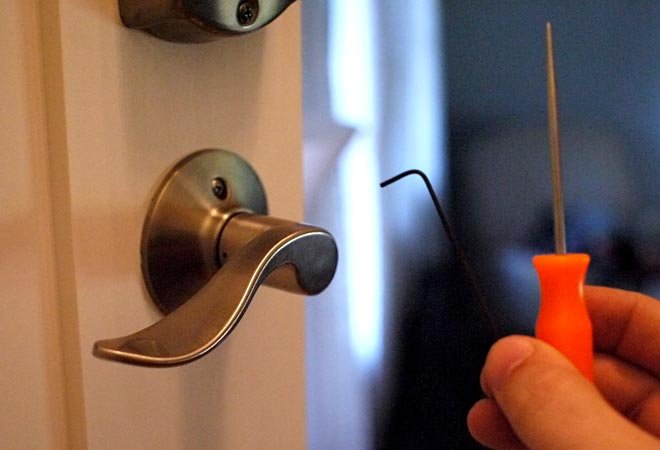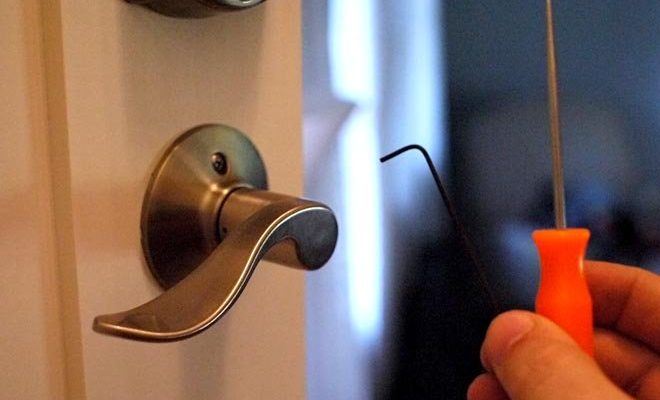
Fixing a loose lever isn’t just about looks, either. That excessive play can be annoying, sure, but over time it can wear out the inner parts or even make it easier for would-be burglars to mess with your lock. Most commonly, you’ll see this on popular brands like Kwikset, Schlage, or Baldwin—lever handlesets that get a daily workout. Luckily, you don’t need to call a locksmith every time it feels wobbly. With the right approach, you can repair most handleset lever problems at home—even if you wouldn’t call yourself “handy.”
What Causes Side-To-Side Play in a Handleset Lever?
Let me explain why that lever feels like it’s about to come off in your hand. Over time, repeated use causes things to loosen up. Most handleset levers (from brands like Schlage and Kwikset) are held together with tiny screws and a spindle that connects both sides. When these parts loosen, the whole lever starts to jiggle side-to-side.
Here’s the thing: it’s not just about screws. Sometimes, the internal cam (a small, hidden mechanism) wears out or the mounting plate shifts out of place. Think of it like a bike handlebar—if the bolts aren’t snug, you’ll start wobbling down the street. Doors get slammed, humidity causes parts to swell or shrink, and all of that adds up. The lever itself, the decorative plate (escutcheon), and the latch mechanism all play a part. Even a small bit of give in one component can create that much-feared lever wiggle.
You might be wondering: Is this normal? Honestly, a *tiny* bit of play is common, especially after years of kids, guests, and groceries banging through. But if you’re feeling more than just a wiggle—a true side-to-side sway—it’s time to check things out. Left alone, it can actually lead to bigger problems, like the lever failing to retract the latch or the lock mechanism jamming up entirely.
Tools and Supplies You’ll Need to Fix a Wobbly Lever
Before you get started, you’ll want to gather a few basic tools. Most repairs are pretty straightforward, but the right gear makes all the difference. Here’s what you’ll need:
- Phillips screwdriver (almost always required for Kwikset, Schlage, or generic handlesets)
- Flathead screwdriver (sometimes needed for decorative plate removal or for faucets with old-style screws)
- Allen wrench (Schlage and some higher-end Baldwin levers use a set screw on the shaft)
- Needle-nose pliers (helpful for gripping tiny screws or pulling out the spindle if needed)
- Replacement screws or spindle (only if yours are stripped, missing, or badly worn)
- Lubricant (like graphite spray, if things feel gritty or sticky inside)
Set everything out on a towel so nothing rolls away. I’ve lost more screws to the abyss under the fridge than I can count. And if your handleset lever uses a key (like a front entry door), be sure to have the key on hand, just in case you need to re-test the lock action after the fix.
Step-By-Step: How to Repair a Handleset Lever with Excessive Play
Let’s get your lever feeling solid again. Take it slow—if you’ve never taken apart a lock before, don’t stress. Here’s a step-by-step approach anyone can follow:
- Inspect for Visible Screws: Look closely at the base of the lever or under the decorative plate. Most brands hide screws behind a thin escutcheon. If you see a tiny hole along the shaft, that’s probably a set screw (use your Allen wrench here).
- Loosen and Remove the Lever: Using the right tool, unscrew the handle from the spindle. Set aside all parts neatly—it’s easy to mix up the order later. If your lever feels stuck, gently wiggle it (sometimes there’s a small clip or catch inside).
- Tighten the Mounting Plate: Underneath the lever, you’ll see the mounting plate that attaches the handleset to the door. Use your Phillips screwdriver to snug up these screws. Don’t over-torque—just firm enough that there’s no movement when you press side-to-side.
- Check the Spindle and Components: If the spindle (the metal rod running through the door) feels loose, it may be worn or misaligned. Try tightening or even replacing it. Lubricate any moving parts with graphite spray if things feel gritty.
- Reassemble the Lever: Put the lever back on, reversing your steps. Test it several times—opening, closing, locking. If you still feel play, double-check that every screw and set screw is tight.
Honestly, most of the time, a full fix is just a matter of tightening or replacing a stripped screw. But if your lever still rocks side to side after all this, the internal cam or latch mechanism may be worn. At that point, it’s worth considering a replacement.
When Should You Replace Instead of Repair?
Here’s the tough love: not every handleset lever can (or should) be fixed. Sometimes, the play isn’t just about loose screws—it’s a symptom of bigger internal wear. I’ve seen Kwikset and Schlage levers last a decade or more, but after thousands of cycles, the internal cam just gives out. If your handle is vintage or already patched up a few times, it might be time to call it.
If you notice any of the following, replacement is probably smarter:
- Stripped or missing screws that won’t tighten, no matter what
- Visible cracks in the lever or mounting plate
- Latch doesn’t retract or gets stuck, even after tightening
- The internal spindle looks bent or rounded off
Here’s the thing: brand-name handlesets (like Schlage or Baldwin) are designed to be robust, but everything wears out eventually. If you’re in doubt, take the old handleset to a home center and ask for a direct replacement. Modern universal handlesets are often “retrofit” ready, so you don’t need to change the entire lock or door—just the lever assembly.
Universal vs Brand-Specific Handleset Levers: What’s the Difference?
You might be wondering if you really need the same brand lever, or if one of those universal handleset levers will do the trick. Here’s my honest take: there are pros and cons.
- Brand-specific levers (like a Schlage to Schlage swap) are generally easier because they align perfectly with your existing screw holes and spindle. You’ll probably have a smoother fit and less fiddling.
- Universal levers are a lifesaver if you have an older or off-brand setup. These usually come with a bunch of included hardware, adapters, and plates to fit most doors. The downside? You *might* need to do a little extra tweaking, especially if your door is thicker or thinner than average.
If you’re dealing with an older Baldwin set or a specialty finish, sourcing the original part can get pricey. Sometimes a universal part really is the best bang for your buck. Just double-check the backset (distance from the edge of the door to the center of the handle), and, if you have a keyed entry, make sure your new lever works with the existing lock cylinder.
Maintaining Your Handleset Lever After Repair
Once you’ve fixed the excessive play, you’ll want to keep your lever from loosening up again—because, let’s face it, nobody wants to do this twice in a year. Handleset levers like those from Kwikset and Schlage benefit from a little regular attention.
- Check Screws Every Few Months: Just zip around with a screwdriver when you’re cleaning or changing batteries in a keypad lock. A quick snug-up now saves trouble later.
- Lubricate Moving Parts: A shot of graphite spray in the latch and spindle area keeps things running smooth. Avoid oil-based products—they attract dust and grime.
- Watch for Sticking or Grinding: If your lever ever feels gritty, don’t ignore it. That’s a sign something’s out of alignment inside. Address it right away, before wear gets worse.
- Don’t Slam the Door: It sounds obvious, but repeated slamming is a big reason handleset levers develop side-to-side play in the first place. A little care goes a long way.
I know maintaining a door handle isn’t usually on the weekend to-do list, but honestly, it’s worth the couple minutes every season. It’ll keep your door feeling solid and secure for years.
Common Mistakes to Avoid During Handleset Lever Repair
It’s easy to get in over your head if you’re new to fixing locks. I’ve seen people strip screws, lose parts, or even lock themselves out while working on their handleset lever. Here’s how to avoid the biggest headaches:
- Don’t Over-tighten: It’s tempting to crank screws super tight. But honestly, that can strip the threads or crack the plate. Firm, gentle pressure is best.
- Keep Track of Small Parts: Work on a tray or towel so nothing rolls away. Some handleset levers have spring-loaded pins that love to disappear.
- Double-Check Lock Alignment: When you reassemble, make sure the lever moves freely and the latch retracts fully. If anything feels “off,” backtrack a step.
- Test Before Finishing Up: Don’t reattach every screw and trim plate until you’ve tested the lever several times with the door open. That way, if something’s wrong, you’re not locked out or starting from scratch.
Take your time, and don’t be afraid to back up if something doesn’t look or feel right. Most handleset lever repairs are forgiving—just go slow and stay organized.
What If the Lever Still Feels Loose After Repair?
If you’ve tried everything—tightened all the screws, checked the spindle, even replaced worn parts—and your handleset lever still has excessive side-to-side play, it’s time to dig deeper.
- Internal Wear: The cam or latch mechanism inside the handleset may be worn down. At this point, the whole lock body (not just the lever) may need replacing.
- Mismatched Parts: Sometimes a previous repair used hardware that doesn’t quite fit your brand of lever. Double-check that every screw, plate, and spindle is the right size for your specific handleset model.
- Door Damage: If your door has warped or the holes are stripped out, even a perfect lever fix won’t hold tight. You might need to repair or reinforce the wood around the handleset mounting area.
If you’re stumped, it might be worth snapping a photo and showing it to the staff at a hardware store. Honestly, the extra set of eyes can spot something you missed. Sometimes a detail as small as a missing washer or an incorrect spindle length can make all the difference.
Wrapping Up: A Solid Door Handle At Last
Living with a wobbly lever gets old fast, but honestly, there’s no reason to put up with it. Most handleset lever issues—whether you have a Schlage, Kwikset, Baldwin, or even a universal setup—can be fixed with basic tools and a bit of patience. Give those screws a once-over, keep everything snug and lubed, and you’ll have a handle that feels as solid as the day it was installed.
You might be surprised how much more secure and satisfying a firm lever feels. And if you run into trouble, remember: you’re not alone. Tons of folks have tackled handleset lever repairs and come out with doors that click, not clunk. So go ahead, give it a go. Your door (and your peace of mind) will thank you.
